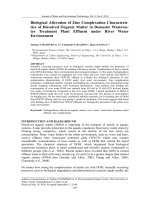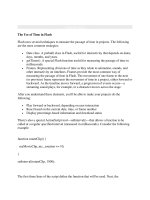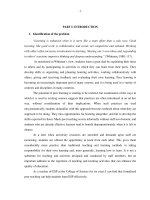The use of water spinach (Ipomoea aquatica) in domestic wastewater treatment
Bạn đang xem bản rút gọn của tài liệu. Xem và tải ngay bản đầy đủ của tài liệu tại đây (425.47 KB, 6 trang )
<span class='text_page_counter'>(1)</span><div class='page_container' data-page=1>
The use of water spinach (Ipomoea aquatica ) in domestic wastewater treatment
Thinh V. D. Nguyen∗, Huong N. T. Huynh, Mai N. H. Nguyen, & Thao V. Ngo
Department of Environmental Sciences, Nong Lam University, Ho Chi Minh City, Vietnam
ARTICLE INFO
Research paper
Received: March 23, 2018
Revised: April 27, 2018
Accepted: May 05, 2018
Keywords
Domestic wastewater
Household
Hydroponics
Wastewater treatment
Water spinach
∗
Corresponding author
Nguyen Vu Duc Thinh
Email:
ABSTRACT
The main objective of this study was to examine the efficacy and
capacity of using hydroponic systems in municipal pollutant removal
at household scale. Three pilot scaled hydroponic systems [dimension
for each system: 4.5 m (L) x Φ 114 mm] were installed to investigate
the optimal age of vegetable, planting density and retention time for
household wastewater treatment, respectively. Water spinach (Ipomoea
aquatica) planted in 27 plastic cups throughout 4.5-m-length and
114-mm-diameter uPVC pipes filled with wastewater was employed as the
treating agent of pollutants. The averaged influent contained
proxi-mately 32.5 mg/L suspended solids (SS), 76.0 mg/L biological
oxy-gen demand (BOD5), 220.5 mg/L chemical oxygen demand (COD), 26
mg/L NH+<sub>4</sub>, 5.0 mg/L NO−<sub>3</sub>, and 8.5 mg/L PO3−<sub>4</sub> at pH 7.3. Results
showed that a designed system consisting of 10 plants of 15-day-old
water spinach pre-planted in baked clay in each cup was capable of
treating 30 L of domestic wastewater meeting the current municipal
wastewater discharge standards in Vietnam (column A standards of
QCVN 14:2008/BTNMT) after 4 days of wastewater retention time. If
operated under conditions of the above parameters, the pilot-plant
hy-droponic system can achieve the removal of 65% SS, 82% BOD5, 74%
COD, 90% NH+4, 30% NO
−
3 and 86% PO
3−
4 . The result of this study
has provided an applicable domestic wastewater treatment system
eco-friendly and suitable for small and medium household areas.
Cited as: Nguyen, T. V. D., Huynh, H. N. T., Nguyen, M. N. H., & Ngo, T. V. (2018). The use of
water spinach (Ipomoea aquatica) in domestic wastewater treatment. The Journal of Agriculture
and Development 17(3),49-54.
1. Introduction
The proportion of domestic wastewater treated
is at low levels, and raw wastewater is usually
dis-charged directly to environment in urban areas
of Vietnam (MONRE, 2016). Currently, 37
col-lective wastewater treatment plants have been in
operation in urban centers of grade III or higher
cities (MONRE, 2016). Wastewater drainage
sys-tems, however, have not been completed, causing
difficulties in collecting and leading wastewater
to treatment plants (MONRE, 2016). Hence, a
domestic wastewater treatment plant at
house-hold scale is necessary to reduce pollutant loads
to environment.
Domestic wastewater can be treated in
differ-ent ways: mechanically, chemically or biologically
</div>
<span class='text_page_counter'>(2)</span><div class='page_container' data-page=2>
dif-ficult to control in the case of planting with
re-circulation systems (Lem et al., 1990).
Ipomoea aquatica, or water spinach, is a
herba-ceous perennial trailing vine (Patnaik, 1976). It
has hollow stems that grow floating or prostrate
(Patnaik, 1976). The roots from the nodes
pen-etrate the soil or mud, and the leaves are
sim-ple and alternate (Patnaik, 1976). This plant
species grows well as a crop in regions where the
mean temperature is above 250<sub>C (Patnaik, 1976).</sub>
Hence, hydroponics in Vietnam is a conducive
en-vironment for water spinach to flourish.
Previous studies have demonstrated that
plant-ing Ipomoea aquatica in fishponds can efficiently
remove nutrients and improve water quality (Li &
Li, 2009; Dai et al., 2012). Accordingly, the
cur-rent study expected that water spinach could use
the nutrients in domestic wastewater for
grow-ing and reducgrow-ing water pollutant loads. Pilot
hy-droponic systems with water spinach were
es-tablished to examine the removal percentages
of municipal pollutants in wastewater from an
apartment. Moreover, the optimal age of water
spinach, planting density and retention time were
also determined for household guidelines.
2. Materials and Methods
2.1. Domestic wastewater characteristics
Domestic wastewater was collected from
col-lecting tank of Sunview Apartment, Cay Keo
Street, Thu Duc District, HCMC, Vietnam in
the morning from January to June 2017
accord-ing to TCVN 6663-1:2011 and ISO 5667-1:2006.
The wastewater parameters included: water
tem-perature 290<sub>C, pH 7.3, SS 32.5 ± 1.5 mg/L,</sub>
BOD576.0 ± 8.0 mg/L, COD 220.5 ± 25.5 mg/L,
NH+<sub>4</sub>−N 26.0 ± 4.0 mg/L, NO−<sub>3</sub>−N 5.0 ± 1.0
mg/L, and PO3−<sub>4</sub> 8.5 ± 1.5 mg/L and did not
vary much throughout the experiments.
Wastew-ater was pre-filtered through a kitchen sieve to
remove large particles, contained in 30-L plastic
buckets and transferred to Environmental
Tech-nology Laboratory of Faculty of Environment and
Natural Resources, Nong Lam University. The
wastewater was then analyzed and employed for
the experiments immediately.
2.2. Conditions of water spinach
Prior to the experimetns, water spinach was
grown hydroponically in baked clay at Institute
of Biotechnology and Environment (IBE), Nong
Lam University. Water spinach seeds were
pro-vided by Phu Nong Seeds Company.
2.3. Experiments
2.3.1. Hydroponic systems
Three pilot scaled experiments consisting
hy-droponic systems [dimension for each system: 4.5
m (L) x Φ 114 mm] were installed with water
spinach to investigate the optimal age of
veg-etable, planting density and hydraulic retention
time (HRT) for household wastewater treatment,
respectively (Figure1). Water spinach (Ipomoea
aquatica) planted in 27 plastic cups throughout
4.5-m-length and 114-mm-diameter uPVC pipes
filled with wastewater was employed as the
treat-ing agent of pollutants. A similar designed pipe
without water spinach was used to make the
con-trol.
Figure 1. Hydroponic pilot (sizes in cm).
The pre-experiments were executed to choose
ranges of vegetables’ optimal age (10, 15 and 20
days old), optimal planting density (5, 10 and 15
plants per cup) and optimal retention time (2, 4
and 6 days).
2.3.2. Determination of the optimal age of
veg-etables
</div>
<span class='text_page_counter'>(3)</span><div class='page_container' data-page=3>
SS, BOD5, COD, NH−4, NO
−
3, and PO
3−
4
concen-trations remaining.
2.3.3. Determination of the optimal planting
density
Fifteen-day-old water spinach was planted in
27 plastic cups with 3 different densities of 5, 10
and 15 plants per cup throughout the pipes,
re-spectively. The control system was made without
vegetables. Thirty liters of domestic wastewater
was added to each hydroponic systems with HRT
= 4 days. Treated wastewater was collected after
HRT to determine SS, BOD5, COD, NH−4, NO
−
3,
and PO3−<sub>4</sub> concentration residues.
2.3.4. Investigate the optimal retention time
Thirty liters of domestic wastewater was added
to each hydroponic systems. Fifteen-day-old
wa-ter spinach was removed from baked clay and
put in 27 lastic cups with the density of 10
plants/cup. There were 3 hydroponic systems
with 3 different HRTs of 2, 4, and 6 days,
re-spectively. A control system was made without
vegetables. Treated wastewater was collected
af-ter HRT to analyze SS, BOD5, COD, NH−4, NO
−
3,
and PO3−4 concentrations remaining.
2.4. Water analysis
The concentrations of SS, BOD5, COD, NH−4,
NO−<sub>3</sub>, and PO3−<sub>4</sub> and pH of the wastewater out
of the hydroponic systems were checked after
hy-draulic retention time. The water sample was
col-lected stochastically from three locations of each
hydroponic system from 8 AM to 9 AM with 100
mL per model.
Chemical oxygen demand was analyzed
accord-ing to SMEWW 5220 D (2012). BOD5 was
ana-lyzed according to TCVN 6001-1:2008 and ISO
5815-1:2003. NH−<sub>4</sub> (LoD = 0.2 mg/L, LoQ = 0.5
mg/L), NO−<sub>3</sub> (LoD = 4 mg/L, LoQ = 10 mg/L)
and PO3−<sub>4</sub> (LoD = 0.04 mg/L, LoQ = 0.1 mg/L)
concentrations were determined by Sera Test Kits
(Germany). In addition, the samples have
con-centrations of NO−<sub>3</sub> less than 20 mg/L were
de-termined by Tropic Marin Test Kits (Germany)
with LoD = 0.5 mg/L and LoQ = 1.5 mg/L. pH
was measured by LAQUAtwin portable pH meter
(HORIBA Scientific, Japan). Temperature was
measured by mercury thermometer. Each
mea-surement was made 3 times.
3. Results
3.1. Optimal age of water spinach
After 4 days, SS, BOD5, COD, NH−4, NO
−
3,
and PO3−<sub>4</sub> concentrations of wastewater in the
hydroponic systems containing 10, 15, and
20-day-old water spinach were 13.0 ± 1.5, 15.0 ±
2.0, 61.0 ± 5.0, 4.0 ± 1.0, 3.0 ± 0.5 and 2.0 ± 0.5
mg/L; 11.8 ± 1.3, 13.5 ± 2.5, 57.5 ± 5.5, 2.5 ±
0.5, 3.5 ± 0.5 and 1.2 ± 0.2 mg/L; and 16.0 ± 1.0,
15.5 ± 2.0, 67.5 ± 6.5, 3.5 ± 0.5, 4.0 ± 1.0 and
2.5 ± 0.5 mg/L, respectively (Figure2). The pH
values ranged from 7.9 to 8.1 in the three systems.
As a result, the efficiency of the system with
15-day-old water spinach was greater than that of
the other systems. Therefore, 15-day-old water
spinach was employed for the next experiments.
Figure 2. Treated wastewater parameters in
hydro-ponics with different initial ages of water spinach.
3.2. Optimal planting density
</div>
<span class='text_page_counter'>(4)</span><div class='page_container' data-page=4>
Figure 3. Treated wastewater parameters in
hydro-ponics with different planting densities.
3.3. Optimal retention time
After HRT = 2 days, SS, BOD5, COD, NH−4,
NO−<sub>3</sub>, and PO3−<sub>4</sub> concentrations of wastewater in
the experimental hydroponic system were 19.5 ±
1.5, 53.0 ± 6.0, 97.0 ± 15.0, 3.0 ± 0.5, 4.0 ± 1.0 &
2.0 ± 0.5 mg/L, respectively (Figure4a) and pH
was 7.5 ± 0.1 while those of the control system
were 24.0 ± 1.0, 68.0 ± 8.0, 160.0 ± 20.0, 24.0 ±
4.0, 5.0 ± 1.0 and 7.5 ± 0.5 mg/L, respectively
(Figure4b) and pH was 7.1 ± 0.2. After HRT =
4 days, SS, BOD5, COD, NH−4, NO
−
3, and PO
3−
4
concentrations of wastewater in the experimental
hydroponic system were 11.5 ± 1.5, 13.5 ± 5.5,
57.0 ± 8.0, 2.5 ± 0.5, 3.5 ± 0.5 and 1.2 ± 0.3
mg/L respectively (Figure4a) and pH was 7.8 ±
0.1 while those of the control system were 18.0
± 1.5, 60.0 ± 6.0, 146.5 ± 18.0, 24.0 ± 4.0, 20.0
± 2.0 and 7.0 ± 0.5 mg/L respectively (Figure
4b) and pH was 6.8 ± 0.1. These parameters met
the current municipal wastewater discharge
stan-dards in Vietnam (column A stanstan-dards of QCVN
14:2008/BTNMT).
After HRT = 6 days, SS, BOD5, COD, NH−4,
NO−<sub>3</sub>, and PO3−<sub>4</sub> concentrations of wastewater in
the experimental hydroponic system were 3.5 ±
0.5, 6.0 ± 1.0, 36.0 ± 7.0, 2.5 ± 0.5, 3.0 ± 0.5 and
1.2 ± 0.5 mg/L respectively (Figure4a) and pH
was 8.1 ± 0.1 while those of the control system
were 7.0 ± 1.0, 52.0 ± 6.0, 112.0 ± 15.0, 22.0 ±
4.0, 25.0 ± 3.0 and 7.0 ± 1.0 mg/L respectively
(Figure4b) and pH was 6.5 ± 0.1.
Figure 4. Treated wastewater parameters in (a)
hy-droponics with different HRTs and (b) the control
system.
4. Discussion
4.1. Hydroponics with water spinach
In general, a hydroponic system consisting of
10 plants of 15-day-old water spinach pre-planted
in baked clay in each cup could process 30 L of
do-mestic wastewater to meet the current municipal
wastewater discharge standards in Vietnam
(col-umn A standards of QCVN 14:2008/BTNMT) at
a HRT of 4 days.
4.1.1. pH
</div>
<span class='text_page_counter'>(5)</span><div class='page_container' data-page=5>
CO2 for photosynthesis, so the pH of water was
increased. CO2 in the water reacts with water
to produce H+ and bicarbonate to decrease pH
of water according to the mechanism: : CO2 +
H2O H2CO3 H+ + HCO−3 (Kanabkaew &
Puetpaiboon, 2004). Because CO2 for
photosyn-thesis of aquatic plants is absorbed faster than
the amount of CO2 generated from the
respira-tory process of the quatic plants, plants must take
CO2from the metabolism of HCO−3 (2HCO
−
3 →
CO2 + CO2−3 + H2O) (Kanabkaew &
Puetpai-boon, 2004). Therefore, the pH of water increases.
4.1.2. SS removal
The SS concentration decreased from 32.5 ±
1.5 mg/L to 11.8 ± 1.3 mg/L (Figure4a), which
means 65% of SS was removed from the
wastew-ater. The removal of SS may be due to
sedimen-tation or/and breakdown of microorganisms and
plants.
4.1.3. COD and BOD5 removal
Previous research has show that COD and
BOD5 can be assimilated by plants (Vymazal
& Kropfelova, 2009). The microbes around the
roots can also contribute to the purification. The
flourishing roots can provide a comfortable
envi-ronment for microbes. Thus, the organic matter
can be removed effectively. The concentrations
of COD and BOD5 decreased from 220.5 ± 25.5
mg/L to 57.5 ± 5.5 mg/L and from 76.0 ± 8.0
mg/L to 13.5 ± 2.5 mg/L, respectively (Figure
4a). 74% of the COD and 82% of the BOD5were
removed from the wastewater. The efficiency of
removal at different HRTs was quite difference.
The efficiency of short HRT (2 days) was lower
than that of middle HRT (4 days) (Figure 4).
This could be because the plants needed a period
of time to adapt to the new environment. When
the roots grew flourishing, the plants could purify
the water by assimilation of organic matters and
nutrients.
4.1.4. Nitrogen removal
The concentrations of NH+<sub>4</sub>and NO−<sub>3</sub> in
wastewater decreased from 26.0 ± 4.0 mg/L to
2.5 ± 0.5 mg/L and from 5.0 ± 1.0 mg/L to 3.5
± 0.5 mg/L, respectively (Figure4a). 90% of the
NH+<sub>4</sub>−N and 30% of the NO−<sub>3</sub>−N were removed
from the wastewater. The nitrogen in wastewater
existed in the form of organic nitrogen, NH+<sub>4</sub>−N
and NO−<sub>3</sub>−N. In the current study, the removal of
odd nitrogen in wastewater relied on the
assim-ilation of these compounds by water spinach in
hydroponic systems. Firstly, NH+<sub>4</sub> was converted
to NO−<sub>3</sub> and a portion of NO−<sub>3</sub> would then be
denitrificated to N2 by microorganisms. Another
NO−<sub>3</sub> portion was absorbed by water spinach via
roots for growing. However, which process
con-tributed more to the NO−<sub>3</sub> removal was not
clar-ified. In other words, NO−<sub>3</sub> could be assimilated
by plants or sent back to the atmosphere by the
effect of denitrifying microorganisms (Xu et al.,
1999).
4.1.5. Phosphorus removal
Phosphorus is the essential nutrient for plant
growth. It can be assimilated by plants and be
converted into various kinds of organic matter of
plants (Gu et al., 2008). Water spinach, therefore,
could assimilate PO3−<sub>4</sub> in wastewater and make
a reduction from 8.5 ± 1.5 mg/L to 1.2 ± 0.2
mg/L. Eighty six percent of PO3−<sub>4</sub> were removed
from the wastewater.
4.2. Control system
On one hand, after HRT we observed moss
stricking on the inner surface of pipes in the
control system. On the other hand, SS created
a visible layer of sediment on the inner surface.
Moreover, activities of microorganisms could also
break organic matters down in wastewater.
Con-sequently, SS, BOD5 and COD decreased
(Fig-ure 4b). Level of pH declined from 7.3 to 6.5.
That was probably because NH+<sub>4</sub> was nitrificated
to NO−<sub>3</sub> as evidenced by decreasing NH+<sub>4</sub> and
in-creasing NO−<sub>3</sub> concentrations at the end of the
experiment.
4.3. Suggested household hydroponic system
</div>
<span class='text_page_counter'>(6)</span><div class='page_container' data-page=6>
5. Conclusions
The averaged influent contained proximately
220.5 mg/L chemical oxygen demand (COD),
76.0 mg/L biological oxygen demand (BOD5),
32.5 mg/L suspended solids (SS), 26 mg/L
NH4+, 5.0 mg/L NO−<sub>3</sub>, and 8.5 PO3−<sub>4</sub> at pH 7.3.
The designed system consisting of 10 plants of
15-day-old water spinach pre-planted in baked clay
in each cup was capable of treating 30 L of
do-mestic wastewater meeting the current municipal
wastewater discharge standards in Vietnam
(col-umn A standards of QCVN 14:2008/BTNMT)
af-ter 4 days of wastewaaf-ter retention time. If
oper-ated under conditions of the above parameters,
the pilot-plant hydroponic system can achieve
the removal of 74% COD, 82% BOD5, 64% SS,
90% NH+<sub>4</sub>, 30% NO−<sub>3</sub> and 86% PO3−<sub>4</sub> . The result
of this study has provided an applicable
domes-tic wastewater treatment system eco-friendly and
suitable for small and medium household areas.
References
Dai, X., Guo, Y., Qian, H., Hu, W., & Chen, W. (2012).
The purification effect of three vegetables and different
cultivation on aquaculture water from shrimp pond.
Journal of Shanghai Ocean University 21(5), 777-783.
Gu, G. P., Zhou, L. Y., & Wang, S. (2008). Primary Study
on the Removal Efficiency of Nitrogen and Phosphorus
of Eutrophic Water Body by Planted Float Ipomoea
Aquatica Forsk. Auhui Agricultural Science Bulletin
14(19), 134-137.
Hoang, H. V., & Tran, H. D. (2014). Drainage (II):
Wastewater treatment. Science and Technology
Publishers, Vietnam, 359-367.
Li, W., & Li, Z. (2009). In situ nutrient removal from
aquaculture wastewater by aquatic vegetable Ipomoea
aquatica on floating beds. Water Science Technology
59(10), 1937-1943.
Luong, P. D. (2011). Wastewater treatment technology
using biological methods. Vietnam: Education
Publish-ers.
MONRE (Ministry of Natural Resources and
Environ-ment of Vietnam). (2016). The National
Environmen-tal Situation Report, 52-54.
Patnaik, S. (1976). Autecology of Impomoea aquatica
Forsk. Journal of Inland Fisheries Society of India 8,
77-82.
Kanabkaew, T., & Puetpaiboon, U. (2004). Aquatic
plants for domestic wastewater treatment: Lotus
(Nelumbo nucifera) and Hydrilla (Hydrillaverticillata)
systems. Songklanakarin Journal Science Technology
26(5), 749-756.
Paul, J., & Cay, B. (1990). Home Hydroponics. New York,
USA: Crown Publishers.
VEA (Vietnam Environment Administration). (2010).
Wastewater treatment by Buffalo Spinach and
Hyacinth. Retrieved February 15, 2018, from
/>ien/caithienmt/Pages/Xulynuocthaibangraungovaluc
binh.aspx.
Vymazal, J., & Kropfelova, L. (2009). Removal of
organ-ics in constructed wetlands with horizontal subsurface
flow: a review of the field experience. Science Total
Environment 407(13), 3911.
</div>
<!--links-->
<a href=''>www.jad.hcmuaf.edu.vn</a>
596 THE USE OF RELATIONSHIP MARKETING TECHNIQUES IN HIGHER EDUCATION A CASE STUDY
- 162
- 1
- 2








